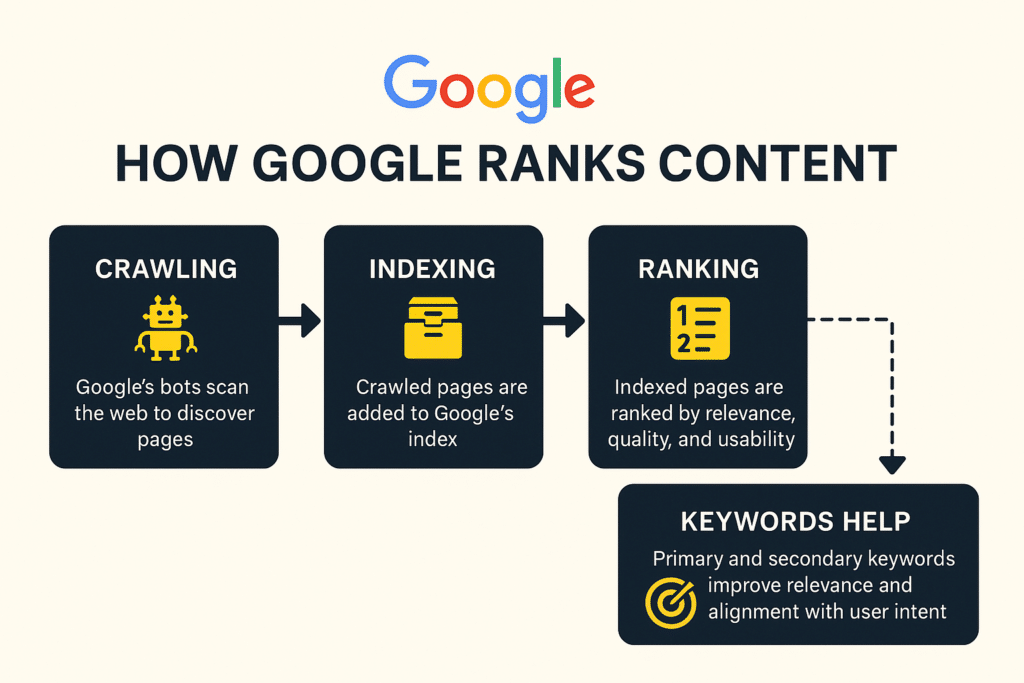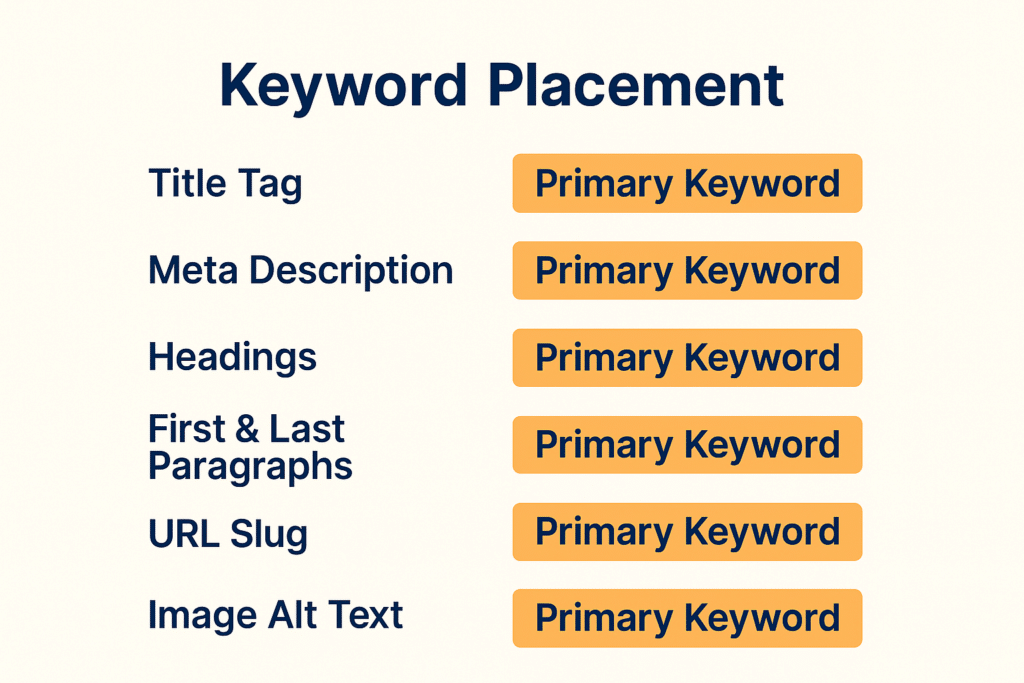

Google ranks content based on relevance, quality, and user experience, making keyword optimization a crucial factor for SEO success. Using the right keywords per page helps search engines understand your content’s intent and improves its chances of ranking higher. By strategically placing primary and secondary keywords in key areas like titles, headings, and meta descriptions, you can enhance visibility while maintaining a natural flow. However, overstuffing or misusing keywords can negatively impact rankings, so balancing keyword density and relevance is essential for sustainable SEO growth.

Primary and secondary keywords play a crucial role in helping Google rank content by improving its relevance and alignment with user intent throughout the search engine’s indexing and ranking process.
Here’s How Keywords Contribute to Ranking:
When Google’s bots scan the web, they analyze content, images, and videos to understand what a page is about.
Using primary and secondary keywords in titles, headings, and meta descriptions helps Google understand your page quickly. It shows what the content is about and why it’s relevant.
If the content is high-quality and unique, it has a better chance of getting indexed. Indexing means Google adds your page to its searchable database to appear in the search results.
After indexing, Google ranks pages based on several factors. These include meaning, relevance, quality, usability and context. Strong keyword use helps your page perform better in this process.
Primary keywords define the page’s main topic and match user search queries directly. Secondary keywords, on the other hand, provide additional context by covering related subtopics or long-tail queries. This comprehensive approach makes the content more useful and relevant to a broader range of users.
By incorporating primary and secondary keywords, content creators can demonstrate expertise, authoritativeness, and trustworthiness (EEAT), which Google prioritizes in its rankings.
Primary keywords are the main phrases or words you want to rank on search engines. These keywords should have a high search volume, meaning the audience wants to search for such content online.
“Conducting thorough keyword research can help you boost SEO efforts without overcrowding content.”
For example, in the blog post topic “A Comprehensive Guide to Learn How Many Keywords Per Page?”, the primary keyword could be the best keyword strategy for SEO
Want your content to rank higher on search engines? One of the most effective ways to improve your content’s visibility is by maintaining an optimal keyword density. The ideal range is 1-2%, ensuring that your content is well-optimized without triggering keyword stuffing penalties.
If you’re writing a 2,000-word article, your primary keyword should appear 20-40 times. This means you should use it once or twice every 100 words to keep a natural flow and enhance readability.

It’s essential to use your primary keyword naturally in strategic locations throughout your content.
Modern Google SEO updates focus on quality over quantity.
Even though you focus on one primary keyword, your page will naturally rank for related secondary keywords due to the semantic relevance and context provided in the content. It is called the Trickle-down effect.
Targeting one primary keyword per page helps to organize your website’s structure more effectively. Each website page can be designed to serve a specific purpose to make it easier for users and search engines to understand your site.
Focusing on one primary keyword optimize meta tags like title tags and meta descriptions. These elements are crucial for search engine results pages (SERPs) and should reflect the page’s main topic.
Multiple primary keywords on a single page can dilute the impact of each keyword. It reduces the ranking for the targeted keywords, as the content may not be strongly associated with any one of them.

Secondary keywords are search queries that are closely related to your primary Keywords. They can be synonyms, variations or long-tail phrases that provide additional context and help search engines understand what your content is about. For example…
To make content relevant and effective, aim for 3 to 5 secondary keywords per page. This helps search engines understand your topic better without overloading your content with excessive variations.
Unlike primary keywords, secondary keywords should have a lower density—ideally 0.5% or less of the total word count. For example:
Keeping this balance prevents over-optimization and ensures a smooth, natural flow.
In conclusion, primary and secondary keywords work together to improve content discoverability, relevance and value. They help Google understand the content better and rank it higher by aligning with user experiences and intent. Using them strategically ensures better visibility and a stronger online presence.
How do I rank a page for multiple keywords?
What is considered keyword stuffing?
Can multiple pages rank for the same keyword?
How many keywords per 100 words?
What will happen if too many keywords are targeted on a single landing page?
How Many Primary Keywords Per Page?
How many keywords can you rank for with one page?
Should you optimize a page for multiple keywords?
Schedule a Call and Get a 7-Day Free Trial
No Credit Card Required
Schedule a Call and Get a 7-Day Free Trial
No Credit Card Required
What’s Included in the Trial:
✓7 days of work across six key technologies
✓Access to premium tools needed for your projects
✓No questions asked if you choose not to continue afterward
✓Transparent communication with daily progress updates
✓Fast turnaround to help you meet tight deadlines
✓ Opportunity to test our workflow and collaboration process firsthand
Stellites partners with digital agencies as a white-label provider for their talent and development needs. We offer top-tier professionals in Digital Marketing, SEO, Paid Advertising, as well as WordPress, Shopify, and other platforms—available on a full-time or pay-as-you-go basis.
At Stellites, our white-label development services are designed to deliver 100% pixel-perfect and technically complex projects within competitive timelines, allowing your agency to scale effortlessly and impress your clients.
Stellites partners with digital agencies as a white-label provider for their talent and development needs. We offer top-tier professionals in Digital Marketing, SEO, Paid Advertising, as well as WordPress, Shopify, and other platforms – available on a full-time or pay-as-you-go basis.
At Stellites, our white-label development services are designed to deliver 100% pixel-perfect and technically complex projects within competitive timelines, allowing your agency to scale effortlessly and impress your clients.
COPYRIGHT © 2025 Stellites Technologies. All Rights Reserved.
Get 15% Discount on all product
Enter your email to receive your exclusive coupon and start saving on your next purchase. Don’t miss out on special deals and updates!
[contact-form-7 id="702acf5" title="Get Coupon Code"]